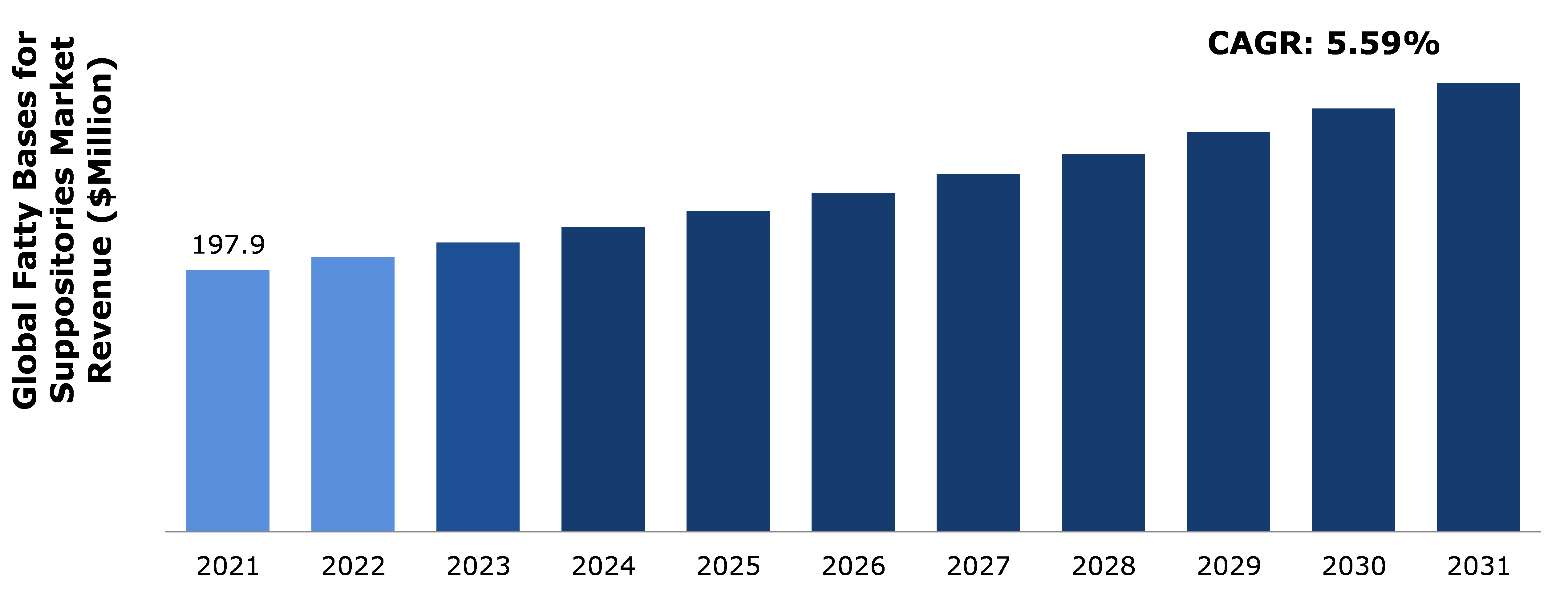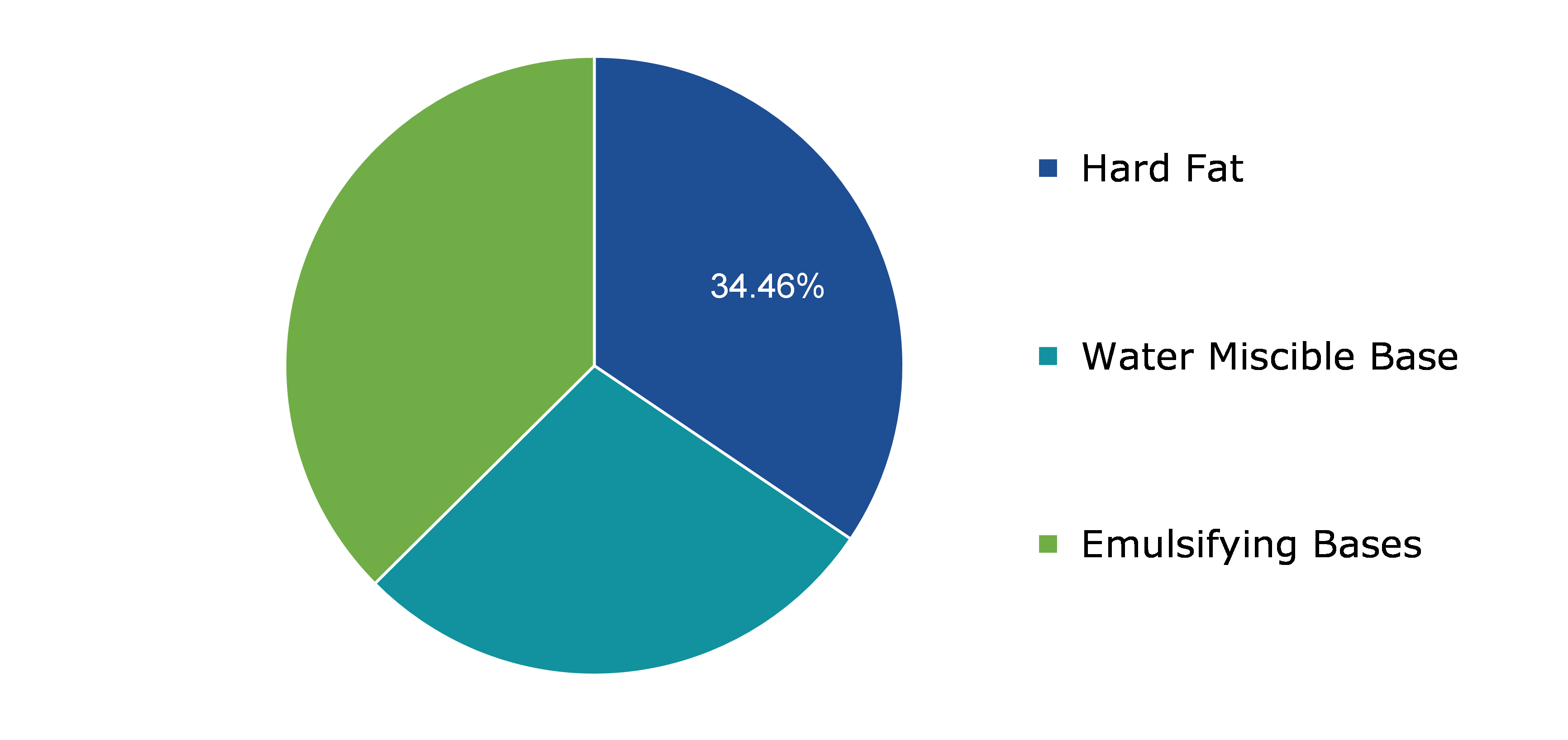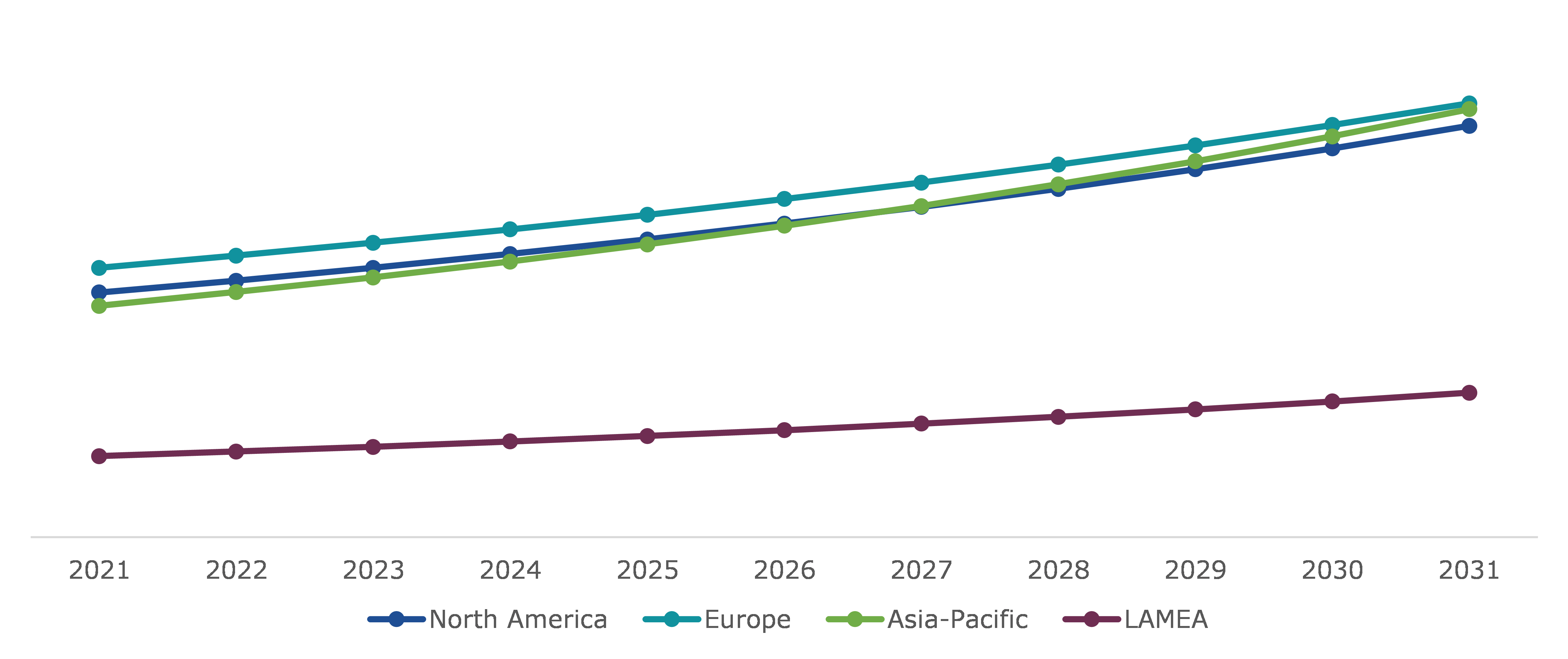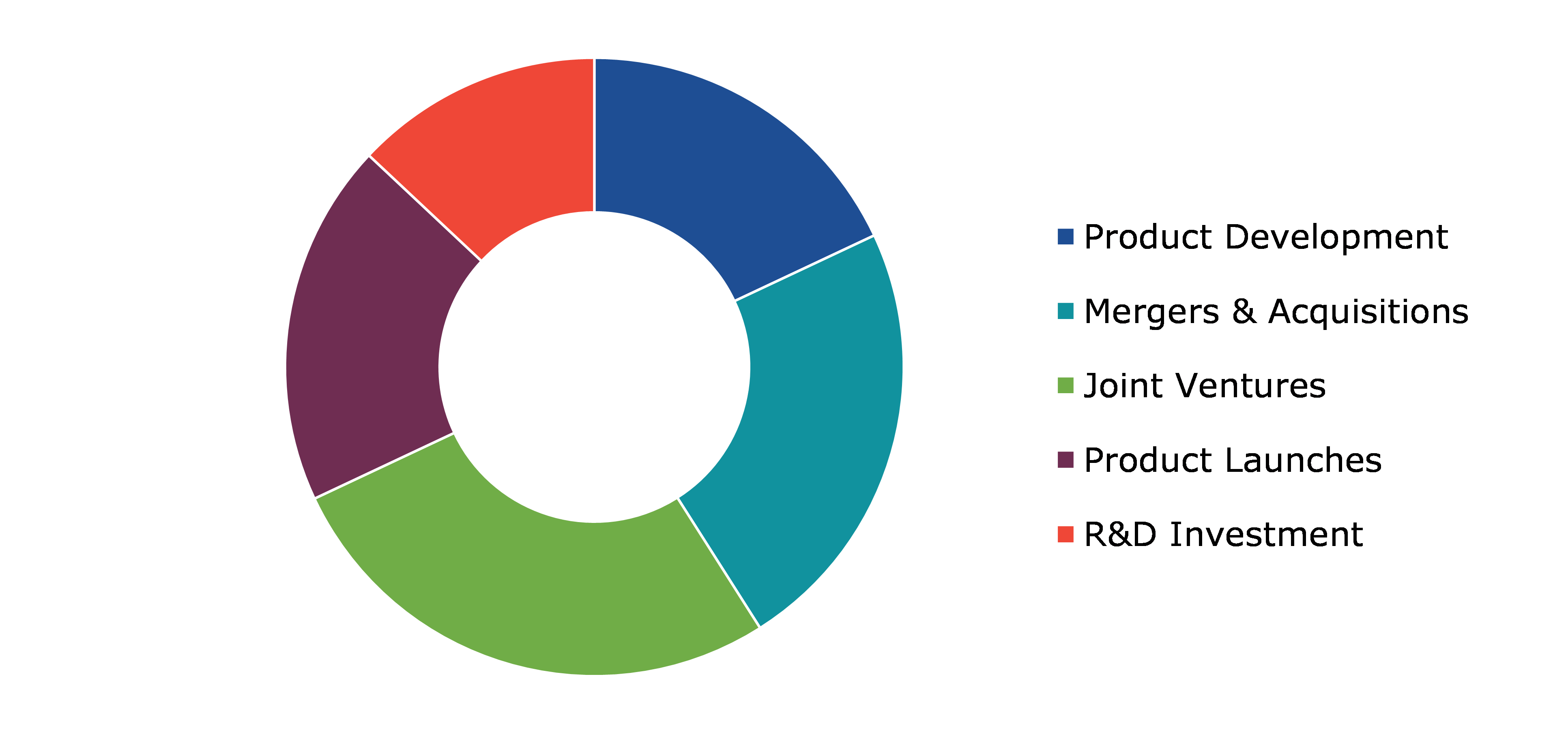Fatty Bases For Suppositories Market Report
RA00406
Fatty Bases for Suppositories Market by Base Type (Hard fat, Water Miscible Base, and Emulsifying Bases) and Regional Analysis (North America, Europe, Asia-Pacific, and LAMEA): Global Opportunity Analysis and Industry Forecast, 2022-2031
Global Fatty Bases for Suppositories Market Analysis
The Global Fatty Bases for Suppositories Market Size were $197.9 million in 2021 and is predicted to grow with a CAGR of 5.59%, by generating revenue of $339.5 million by 2031.
Global Fatty Bases for Suppositories Market Synopsis
Suppositories are dose forms that are placed into bodily cavities, most frequently the rectum, to deliver medication to the local tissues or the systemic circulation. Suppositories can be beneficial additions to the toolbox for managing symptoms, particularly for patients who are unable to take medications orally due to nausea and vomiting, severe disease, or neurological deficiency. Drug administration is greatly aided by the use of fat-based suppositories, especially in elderly and young patients. In these populations, the rectal route is a great choice for drug delivery. Additionally, the rise in demand for fat-based excipients is primarily driven by their advantages, such as the possibility of lymphatic system absorption and rapid absorption of numerous low molecular weight medications.
However, lack of flexibility in commercially supplied suppositories' dosage leads to underuse and scarcity. Additionally, it is thought that the difficulties in producing oil-based suppositories may somewhat restrain the market's growth.
The highly developed healthcare industries are looking for an improved drug or better alternative that might successfully aid patients in recovering from infectious disorders. The majority of countries' ongoing research by numerous institutes suggests a high likelihood of developing antiretroviral suppository drug delivery. These delivery systems are actively being developed and provide solutions that are both effective and affordable for patients.
According to regional analysis, the European market for fatty bases for suppositories accounted for the highest share in 2021 and is predicted to grow with a CAGR of 5.59% in the projected timeframe.
Fatty Bases for Suppositories Overview
Suppositories are solid objects of varying weights and sizes that are designed to be inserted into a person's rectal, vaginal, or urethral opening. At body temperature, they frequently melt, soften, or dissolve. A suppository may serve to prevent or treat local problems at the site of introduction, or it may transport medicinal substances for either local or systemic activity. PCCA MBKTM (Fatty Acid), Cocoa Butter NF, and other fatty compounds are examples of the melting type of bases. Polyethylene glycol (PEG) is present in dissolving bases such as PCCA Base A (Polyethylene Glycol 1450 MW, NF) or bases made from Polyethylene Glycol NF combinations.
COVID-19 Impact on Global Fatty Bases for Suppositories Market
The coronavirus (COVID-19) was discovered in Wuhan, Hubei Province, China, at the end of December. The illness is brought on by the contagious SARS-CoV-2 (severe acute respiratory syndrome coronavirus 2) virus. Due to a breakdown in the supply chain for raw materials, COVID-19 interfered with the production of medicinal suppositories in 2020. Furthermore, lockdown forced the major manufacturing plants to shut down since the manpower needed for manufacturing factories was redirected to quarantine or lockdown. The COVID-19 pandemic had an unfavorable overall effect on the pharmaceutical suppositories market because of the disruption in the supply chain, which led to financial difficulties, a labor shortage, and an increase in the demand and supply imbalance. The pandemic created several uncertainties, resulting in significant economic losses as various businesses around the world came to a halt. This has ultimately lowered the demand for fatty bases for suppositories due to disruptions in the supply chain, closure of manufacturing plants, and economic slowdown across several countries.
The Huge Significance of Fat Suppositories in The Geriatric and Pediatric Patients is Anticipated to Drive the Global Market
The rise in the number of elderly people is what is fueling the demand for medicinal suppositories. The rectal route is the best alternative for medicine delivery in this population. Due to advantages including quick absorption of several low molecular weight medications and the potential for lymphatic system absorption, there will be an increase in demand for suppositories throughout the anticipated time. Additionally, the market for suppositories is anticipated to rise as a result of their better physical and chemical stability, lack of irritating effects on mucosal membranes, and broad chemical compatibility. For instance, there is ongoing research on using natural products as suppositories, such as ghee, due to their excellent qualities. Its capacity to smoothen the skin, ability to lower plasma levels of low-density lipoprotein cholesterol, and lipophilic nature allow greater absorption. These factors are anticipated to boost the fatty bases for suppositories market share in forecasted timeframe.
To know more about global fatty bases for suppositories market drivers, get in touch with our analysts here.
The Reluctance of Patients to Prefer Rectal Drug Delivery is Anticipated to Restrain the Global Fatty Bases for Suppositories Market Growth
The fatty bases for suppositories have a long history of usage in rectal and vaginal drug delivery; the current global market for these products is constrained primarily by a lack of consumer acceptance and willingness to utilize rectal products. Additionally, it is thought that the difficulties in producing oil-based suppositories may somewhat restrain the market's growth. These factors will limit the growth of the fatty base for suppositories market opportunity in the forecasted time frame.
The Importance of Fat Excipients for the Treatment of Viral Infections is Expected to Create a Lucrative Opportunity in the Global Market
Availability of enhanced healthcare infrastructure and advanced diagnosis facilities is anticipated to propel market expansion for fat excipients for viral treatment. Additionally, the widespread use of fatty excipients in drug delivery systems in the treatment of viral infections is rising due to advancements in the pharmaceutical industry and rise in popularity of suppositories in treatment of small children’s and elderly. Furthermore, there is likely to be huge potential for the growth of the market for fatty bases for suppositories due to the significant increase in R&D initiatives to develop treatments for viral infection using fat excipients.
To know more about global fatty bases for suppositories market opportunities, get in touch with our analysts here.
Global Fatty Bases for Suppositories Market, by Base Type
Based on base type, the market has been divided into hard fat, water miscible base and emulsifying base. Among these, emulsifying base sub-segment accounted for the highest market share in 2021, whereas the coal sub-segment is estimated to show the fastest growth during the forecast period.
Global Fatty Bases for Suppositories Market Growth, by Base Type, 2021
Source: Research Dive Analysis
The emulsifying base sub-type is anticipated to have a dominant market share in 2021. Emulsifying bases have unique qualities that are not shared by other ointment bases, such as their texture, neutrality, stability, and ability to combine substances that are physically incompatible. They combine sweat and serum, but neither dehydrates the body nor do they appear to have an osmotic effect on serous exudate; in fact, they use both sweat and serum for therapeutic purposes. Some of the commonly used emulsifying bases are witepsol, massa esterium, and massuppol. It contains glyceryl esters and a small amount of glyceryl monostearate in these massuppol, which is added to improve the water-absorbing capacity.
The water miscible base sub-type is anticipated to show the fastest growth in the forecast timeframe. A water-miscible base is also known as an emulsion or a water-removable base. These water miscible bases are washable or removable in water since they have an aqueous exterior phase. They are less occlusive and non-greasy than oleaginous bases. They have a superior aesthetic look when diluted with water. Water-miscible bases with a high viscosity are frequently referred to as “creams”. These are the ointment bases that are most frequently used. Most dermatologic medication preparations have an emulsion or cream base.
Global Fatty Bases for Suppositories Market, Regional Insights
The Fatty Bases for Suppositories market was investigated across North America, Europe, Asia-Pacific, and LAMEA.
Global Fatty Bases for Suppositories Market Size & Forecast, by Region, 2021-2031 (USD Million)
Source: Research Dive Analysis
The Market for Fatty Bases for Suppositories in Europe to be the Most Dominant
The Europe fatty bases for suppositories market accounted for a considerable share in 2021.Due to its highly developed healthcare sector, the presence of large producers, and the region's high rate of suppository adoption, North America held the lion's share of the global market for pharmaceutical suppositories. The demand for fatty bases for suppositories is anticipated to be boosted by high R&D spending and ongoing technological advances, which is also anticipated to boost the growth of the European fatty base for suppositories market. Furthermore, the increase in demand for suppositories among parents for their children in European region is increasing, which is anticipated to boost the fatty bases for suppositories market opportunity during forecasted time period.
Competitive Scenario in the Global Fatty Bases for Suppositories Market
Investment and agreement are common strategies followed by major market players.
Source: Research Dive Analysis
Some of the leading fatty bases for suppositories market players are Unither, Bliss GVS Pharma Ltd., Delpharm, ATRAL, Aenova Holding GmbH, FAMAR, LGV (Laboratories Mayoly Spindler), Priyans Drugs. Fatty bases for suppositories industry players are concentrating on technological advancements, showcasing product portfolio, and mergers & acquisitions.
| Aspect | Particulars |
| Historical Market Estimations | 2020 |
| Base Year for Market Estimation | 2021 |
| Forecast Timeline for Market Projection | 2022-2031 |
| Geographical Scope | North America, Europe, Asia-Pacific, and LAMEA |
| Segmentation by Bases Type |
|
| Key Companies Profiled |
|
Q1. What is the size of the global fatty bases for suppositories market?
A. The size of the global fatty bases for suppositories market was over $197.9 million in 2021 and is projected to reach $339.5 million by 2031.
Q2. Which are the major companies in the fatty bases for suppositories market?
A. FAMAR, LGV (Laboratories Mayoly Spindler), and Priyans Drugs are some of the key players in the global fatty bases for suppositories market.
Q3. Which region, among others, possesses greater investment opportunities in the near future?
A. Asia-Pacific possesses great investment opportunities for investors to witness the most promising growth in the future.
Q4. What will be the growth rate of the Asia-Pacific fatty bases for suppositories market?
A. Asia-Pacific global fatty bases for suppositories market are anticipated to grow at 6.39% CAGR during the forecast period.
Q5. What are the strategies opted by the leading players in this market?
A. Mergers & acquisitions and advanced product development are the two key strategies opted by the operating companies in this market.
Q6. Which companies are investing more on R&D practices?
A. Unither, Bliss GVS Pharma Ltd., and Delpharm are the companies investing more on R&D activities for developing new products and technologies.
1.Research Methodology
1.1.Desk Research
1.2.Real time insights and validation
1.3.Forecast model
1.4.Assumptions and forecast parameters
1.5.Market size estimation
1.5.1.Top-down approach
1.5.2.Bottom-up approach
2.Report Scope
2.1.Market definition
2.2.Key objectives of the study
2.3.Report overview
2.4.Market segmentation
2.5.Overview of the impact of COVID-19 on Global fatty bases for suppositories market
3.Executive Summary
4.Market Overview
4.1.Introduction
4.2.Growth impact forces
4.2.1.Drivers
4.2.2.Restraints
4.2.3.Opportunities
4.3.Market value chain analysis
4.3.1.List of raw material suppliers
4.3.2.List of manufacturers
4.3.3.List of distributors
4.4.Innovation & sustainability matrices
4.4.1.Technology matrix
4.4.2.Regulatory matrix
4.5.Porter’s five forces analysis
4.5.1.Bargaining power of suppliers
4.5.2.Bargaining power of consumers
4.5.3.Threat of substitutes
4.5.4.Threat of new entrants
4.5.5.Competitive rivalry intensity
4.6.PESTLE analysis
4.6.1.Political
4.6.2.Economical
4.6.3.Social
4.6.4.Technological
4.6.5.Environmental
4.7.Impact of COVID-19 on fatty bases for suppositories market
4.7.1.Pre-covid market scenario
4.7.2.Post-covid market scenario
5.Fatty Bases for Suppositories Market Analysis, by Base Type
5.1.Overview
5.2.Hard Fat
5.2.1.Definition, key trends, growth factors, and opportunities
5.2.2.Market size analysis, by region, 2021-2031
5.2.3.Market share analysis, by country, 2021-2031
5.3.Water Miscible Base
5.3.1.Definition, key trends, growth factors, and opportunities
5.3.2.Market size analysis, by region, 2021-2031
5.3.3.Market share analysis, by country, 2021-2031
5.4.Emulsifying Bases
5.4.1.Definition, key trends, growth factors, and opportunities
5.4.2.Market size analysis, by region, 2021-2031
5.4.3.Market share analysis, by country, 2021-2031
5.5.Research Dive Exclusive Insights
5.5.1.Market attractiveness
5.5.2.Competition heatmap
6.Fatty Bases for Suppositories Market, by Region
6.1.North America
6.1.1.U.S.
6.1.1.1.Market size analysis, by Base Type, 2021-2031
6.1.2.Canada
6.1.2.1.Market size analysis, by Base Type, 2021-2031
6.1.3.Mexico
6.1.3.1.Market size analysis, by Base Type, 2021-2031
6.1.4.Research Dive Exclusive Insights
6.1.4.1.Market attractiveness
6.1.4.2.Competition heatmap
6.2.Europe
6.2.1.Germany
6.2.1.1.Market size analysis, by Base Type, 2021-2031
6.2.2.UK
6.2.2.1.Market size analysis, by Base Type, 2021-2031
6.2.3.France
6.2.3.1.Market size analysis, by Base Type, 2021-2031
6.2.4.Spain
6.2.4.1.Market size analysis, by Base Type, 2021-2031
6.2.5.Italy
6.2.5.1.Market size analysis, by Base Type, 2021-2031
6.2.6.Rest of Europe
6.2.6.1.Market size analysis, by Base Type, 2021-2031
6.2.7.Research Dive Exclusive Insights
6.2.7.1.Market attractiveness
6.2.7.2.Competition heatmap
6.3.Asia Pacific
6.3.1.China
6.3.1.1.Market size analysis, by Base Type, 2021-2031
6.3.2.Japan
6.3.2.1.Market size analysis, by Base Type, 2021-2031
6.3.3.India
6.3.3.1.Market size analysis, by Base Type, 2021-2031
6.3.4.Australia
6.3.4.1.Market size analysis, by Base Type, 2021-2031
6.3.5.South Korea
6.3.5.1.Market size analysis, by Base Type, 2021-2031
6.3.6.Rest of Asia Pacific
6.3.6.1.Market size analysis, by Base Type, 2021-2031
6.3.7.Research Dive Exclusive Insights
6.3.7.1.Market attractiveness
6.3.7.2.Competition heatmap
6.4.LAMEA
6.4.1.Brazil
6.4.1.1.Market size analysis, by Base Type, 2021-2031
6.4.2.Saudi Arabia
6.4.2.1.Market size analysis, by Base Type, 2021-2031
6.4.3.UAE
6.4.3.1.Market size analysis, by Base Type, 2021-2031
6.4.4.South Africa
6.4.4.1.Market size analysis, by Base Type, 2021-2031
6.4.5.Rest of LAMEA
6.4.5.1.Market size analysis, by Base Type, 2021-2031
6.4.6.Research Dive Exclusive Insights
6.4.6.1.Market attractiveness
6.4.6.2.Competition heatmap
7.Competitive Landscape
7.1.Top winning strategies, 2021
7.1.1.By strategy
7.1.2.By year
7.2.Strategic overview
7.3.Market share analysis, 2021
8.Company Profiles
8.1.Unither
8.1.1.Overview
8.1.2.Business segments
8.1.3.Product portfolio
8.1.4.Financial performance
8.1.5.Recent developments
8.1.6.SWOT analysis
8.2.Bliss GVS Pharma Ltd.
8.2.1.Overview
8.2.2.Business segments
8.2.3.Product portfolio
8.2.4.Financial performance
8.2.5.Recent developments
8.2.6.SWOT analysis
8.3.Delpharm
8.3.1.Overview
8.3.2.Business segments
8.3.3.Product portfolio
8.3.4.Financial performance
8.3.5.Recent developments
8.3.6.SWOT analysis
8.4.ATRAL
8.4.1.Overview
8.4.2.Business segments
8.4.3.Product portfolio
8.4.4.Financial performance
8.4.5.Recent developments
8.4.6.SWOT analysis
8.5.Aenova Holding GmBH
8.5.1.Overview
8.5.2.Business segments
8.5.3.Product portfolio
8.5.4.Financial performance
8.5.5.Recent developments
8.5.6.SWOT analysis
8.6.FAMAR
8.6.1.Overview
8.6.2.Business segments
8.6.3.Product portfolio
8.6.4.Financial performance
8.6.5.Recent developments
8.6.6.SWOT analysis
8.7.LGV (Laboratories Mayoly Spindler)
8.7.1.Overview
8.7.2.Business segments
8.7.3.Product portfolio
8.7.4.Financial performance
8.7.5.Recent developments
8.7.6.SWOT analysis
8.8.Priyans Drugs
8.8.1.Overview
8.8.2.Business segments
8.8.3.Product portfolio
8.8.4.Financial performance
8.8.5.Recent developments
8.8.6.SWOT analysis
9.Appendix
9.1.Parent & peer market analysis
9.2.Premium insights from industry experts
Related reports
The current healthcare sector is searching for better and more advanced options that can aid in the recovery of patients from infectious disorders. The rectal route is a successful substitute for oral medication administration in geriatric and pediatric patients. Rectal suppositories could affect bioavailability and result in continuous medication release. Suppository drug delivery eliminates issues with oral medication delivery, such as the first pass effect and drug breakdown by gastrointestinal enzymes.
Suppositories are solid drug dosage forms that are specifically made to be inserted into cavities of the body other than the mouth. They can be inserted into the urethra, vaginal canal, or rectum. These components are made to dissolve or melt in the cavity fluids after implantation, releasing the medication. Suppositories are classified as rectal, vaginal, or urethral suppositories depending on where they are inserted. Suppositories are important for on-site action. It does not include the first-pass effect, which protects the medication from metabolism. Suppositories are a useful drug delivery method for bitter and unpleasant medications. Suppositories are frequently used in pediatrics to address symptoms that resemble constipation. The global fatty bases for suppositories market is expanding at a swift pace due to their quick absorption of low molecular weight drugs, retention of large volumes, and the potential for lymphatic system absorption.
New Insights into the Fatty Bases for Suppositories Market
The rising pediatric and geriatric populations across the world, along with the need for easy drug delivery methods are some factors projected to drive the growth of the global fatty bases for suppositories market. As per a report by Research Dive, the global fatty bases for suppositories market is expected to surpass a revenue of $339.5 million in the 2022-2031 timeframe. The Europe fatty bases for suppositories market is predicted to perceive foremost and dominant growth in the years to come. This is because the region has a massive demand for fatty bases for suppositories due to the region's high rate of suppository usage, the existence of significant producers, and a highly developed healthcare industry.
How are Market Players Responding to the Rising Demand for Fatty Bases for Suppositories?
Market players are greatly investing in pioneering research and inventions to cater for the rising demand for fat-based suppositories to treat various diseases. Some of the foremost players in the fatty bases for suppositories market are Bliss GVS Pharma Ltd., Unither, ATRAL, Delpharm, FAMAR, Aenova Holding GmbH, Priyans Drugs, LGV (Laboratories Mayoly Spindler), and others. These players are focused on planning and devising tactics such as mergers and acquisitions, collaborations, novel advances, and partnerships to reach a notable position in the global market. For instance:
- In August 2020, Camber Pharmaceuticals, a specialized generic medicine sales and marketing company, formally announced the launch of Mesalamine suppositories, the generic equivalent of Canasa® suppositories. Suppositories containing mesalamine are used to treat mild to moderate ulcerative colitis.
- In January 2021, CB21 Pharma, focused on the research and development of pharmaceutical-grade cannabidiol products, a sister company of CBDepot, introduced cannabidiol (CBD) suppositories for rectal and vaginal use for OTC (over-the-counter) sales in Europe.
- In August 2021, Gynica, a femtech (female technology) firm in Jerusalem, announced the development of cannabis-based medicines, including specialised vaginal suppositories to treat endometriosis and dysmenorrhea symptoms and relieve pain and inflammation in patients.
COVID-19 Impact on the Global Fatty Bases for Suppositories Market
The unpredicted rise of the coronavirus pandemic in 2020 has adversely impacted the global fatty bases for suppositories market. During the pandemic period, in 2020, COVID-19 disrupted the chain of supply for raw materials, delaying the production of pharmaceutical suppositories. Additionally, the lockdown forced the major industrial facilities to close since the workforce required for production sites was moved to quarantine. The interruptions in the supply chains during the COVID-19 pandemic also resulted in a labor shortage, financial difficulties, and a rise in demand and supply imbalances. All these factors negatively affected the fatty bases for suppositories market. However, with the relaxation of the pandemic, the global market is likely to recover and experience widespread growth in the coming years.
Personalize this research
- Triangulate with your own data
- Request your format and definition
- Get a deeper dive on a specific application, geography, customer or competitor
- + 1-888-961-4454 Toll - Free
- support@researchdive.com





